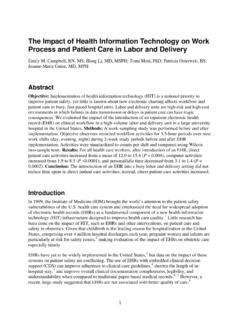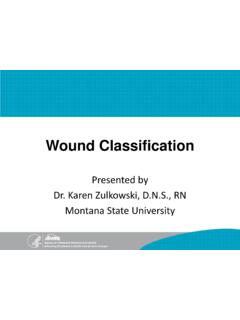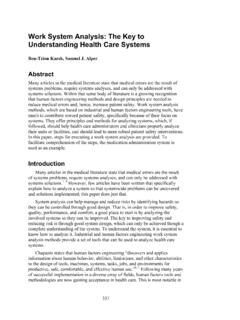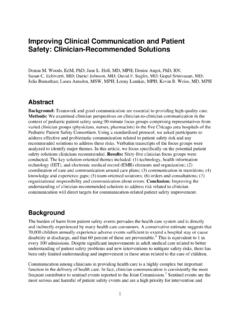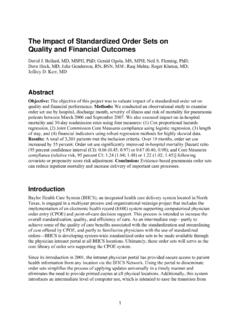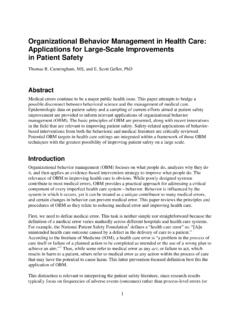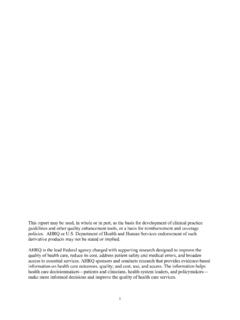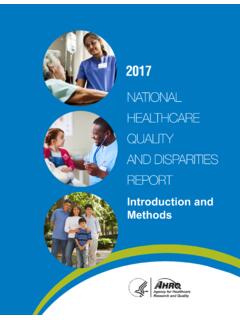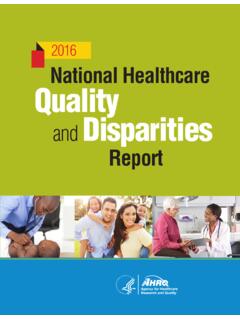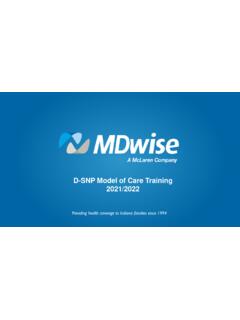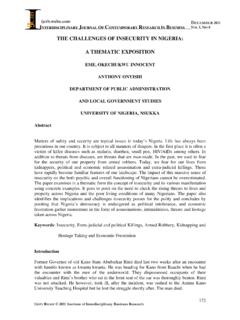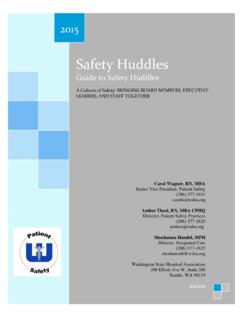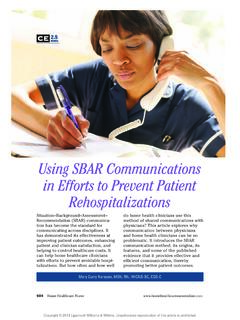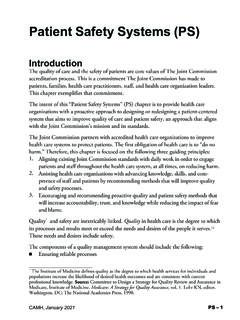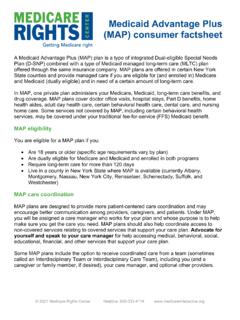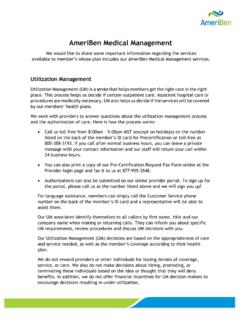Transcription of TeamSTEPPS for Rapid Response Systems
1 ForRapid Response SystemsTMTEAMSTEPPS 1 Page 2 Page 2 RRSO verview What is the Rapid Response System? The Rapid Response System (RRS) is the overarching structure that coordinates all teams involved in a Rapid Response call What is TeamSTEPPS ? The Agency for Healthcare Research and Quality s curriculum and materials for teaching teamwork tools and strategies to healthcare professionals This module of TeamSTEPPS is for RRSTEAMSTEPPS 1 Page 3 Page 3 RRSO verview What is the Rapid Response Team? RRS has several parts, one of them being the Rapid Response Team (RRT) A RRT known by some as the Medical Emergency Team is a team of clinicians who bring critical care expertise to the patient s bedside or wherever it is needed (IHI, 2007) TeamSTEPPS 1 Page 4 Page 4 RRSWhy Should You Care?
2 People die unnecessarily every day in our hospitals It is likely that each of you can provide an example of a patient who, in retrospect, should not have died during his or her hospitalization There are often clear early warning signs of deterioration Establishing a RRS is one of the Joint Commission s 2008 National Patient Safety Goals Teamwork is critical to successful Rapid Response The evidence suggests that RRS work! TeamSTEPPS 1 Page 5 Page 5 RRSDoes it Work?BeforeAfterNo. of cardiac arrests6322 Deaths from cardiac arrest3716No. of days in ICU post arrest16333No. of days in hospital after arrest1363159 Inpatient deaths302222 Bellomo R, Goldsmith D, Uchino S, et al. A prospective before-and-after trial of a medical emergency team.
3 Medical Journal of Australia. 2003;179(6) 1 Page 6 Page 6 RRSDoes the RRS Work? 50% reduction in non-ICU arrestsBuist MD, Moore GE, Bernard SA, Waxman BP, Anderson JN, Nguyen TV. Effects of a medical emergency team on reduction of incidence of and mortality from unexpected cardiac arrests in hospital: preliminary study. BMJ. 2002;324:387-390. Reduced post-operative emergency ICU transfers (58%) and deaths (37%)Bellomo R, Goldsmith D, Uchino S, et al. Prospective controlled trial of effect of medical emergency team on postoperative morbidity and mortality rates. Crit Care Med. 2004;32:916-921. Reduction in arrest prior to ICU transfer (4% vs. 30%)Goldhill DR, Worthington L, Mulcahy A, Tarling M, Sumner A.
4 The patient-at-risk team: identifying and managing seriously ill ward patients. Anesthesia. 1999;54(9):853-860. 17% decrease in the incidence of cardiopulmonary arrests ( vs. per 1000 admissions)DeVita MA, Braithwaite RS, Mahidhara R, Stuart S, Foraida M, Simmons RL. Use of medical emergency team responses to reduce hospital cardiopulmonary arrests. Qual Saf Health Care. 2004;13(4) 1 Page 7 Page 7 RRSNQF Safe Practices In 2003, the National Quality Forum (NQF) identified the RRS as a chief example of a team intervention serving the safe practiceelement of Team Training and Team Interventions RRSs are viewed as an ideal example of safe practices in teamwork meeting the objective of establishing a proactive systemic approach to team-based care In 2006, the NQF updated their Safe Practices recommendations NQF continues to endorse RRSs and concludes that annually organizations should formally evaluate the opportunity for using Rapid Response Systems to address the issues of deteriorating patients (NQF, 2006)
5 TeamSTEPPS 1 Page 8 Page 8 RRSJ oint Commission 2008 National Patient Safety Goal Goal 16: Improve recognition and Response to changes in a patient s condition 16A. The organization selects a suitable method that enables health care staff members to directly request additional assistance from a specially trained individual(s) when the patient s condition appears to be worseningTEAMSTEPPS 1 Page 9 Page 9 RRSI mplementation When implementing RRS, the Institute for Healthcare Improvement (IHI) recommends: Engaging senior leadership Identifying key staff for RRTs Establishing alert criteria and a mechanism for calling the RRT Educating staff about alert criteria and protocol Using a structured documentation tool Establishing feedback mechanisms Measuring effectiveness RRS can be customized to meet your institutions needs and resourcesTEAMSTEPPS 1 Page 10 Page 10 RRSRRS StructureTEAMSTEPPS 1 Page 11 Page 11 RRSA ctivator(s) Activators can be.
6 Floor staff A technician The patient A family member Specialists Anyone sensing the acute deteriorationTEAMSTEPPS 1 Page 12 Page 12 RRSR esponder(s) Responders come to the bedside and assess the patient s situation Responders determine patient disposition, which could include: Transferring the patient to another critical care unit ( , ICU or CCU) A handoff back to the primary nurse/primary physician Revising the treatment plan Activators may become Responders and assist in stabilizing the patientTEAMSTEPPS 1 Page 13 Page 13 RRSA ctivators & Responders Activator(s) are responsible for calling the Responder(s) if a patient meets the calling criteria Responders must reinforce the Activator(s) for calling:Remember: There are no bad calls !
7 Thank you for calling. What is the situation? Why did you call ? 1 Page 14 Page 14 RRSS upport: Quality Improvement & Administration The Quality Improvement (QI) Team supports Activators and Responders by reviewing RRS events and evaluating data for the purpose of improving RRS processes The Administration Team of the RRS brings organizational resources, support, and leadership to the entire RRS and ensures that changes in processes are implemented if necessaryTEAMSTEPPS 1 Page 15 Page 15 RRSLet s Watch the RRS in ActionTEAMSTEPPS 1 Page 16 Page 16 RRSC onflictConflictLack of coordination Lack of coordination DistractionsDistractionsFatigueFatigueWo rkloadWorkloadMisinterpretation of cuesMisinterpretation of cuesLack of role clarityLack of role clarityInconsistency in team membershipInconsistency in team membershipLack of timeLack of timeLack of information sharingLack of information sharingTeamwork & RRS The RRS has all these barriers to effective care.
8 TeamSTEPPS 1 Page 17 Page 17 RRSN ecessary Teamwork SkillsTEAMSTEPPS 1 Page 18 Page 18 RRSI nter-Team Knowledge Supports effective transitions in care between units Is a prerequisite for transition support (or boundary spanning ) Consists of understanding the roles and responsibilities of each team within the RRSTEAMSTEPPS 1 Page 19 Page 19 RRSI nter-Team Knowledge In the RRS, inter-team knowledge means all RRS members possess a shared understanding of the roles and responsibilities of all other members Activators must know the roles and responsibilities of Responders and vice versaActivatorsAdministrationQuality ImprovementRespondersTeamworkResponders 1 Page 20 Page 20 RRST ransition Support ( Boundary Spanning ) Requires inter-team knowledge Combines monitoring transitions in care and providing backup behavior when needed Provides role support Example.
9 Activator becoming ResponderTEAMSTEPPS 1 Page 21 Page 21 RRST ransition Support ( Boundary Spanning ) Manage data Monitor transitions Educate staff onsituation and roles Ensure data recording Assist in role orientationActivatorsAdministrationQuali ty ImprovementRespondersTEAMSTEPPS 1 Page 22 Page 22 RRS Activators call Responders using a pager Who are the Responders? ICU Physician ICU Charge Nurse Nurse Practitioner (if available) RRS coordinator Transportation service For Pediatric Unit, chaplain s office, security, and respiratory therapist are also includedExample of One RRSTEAMSTEPPS 1 Page 23 Page 23 RRSE xample of One RRS (continued) Training Includes direct teaching modules on Rapid Response and practice using Situation-Background-Assessment-Recommen dation (SBAR) Online training modules Single-discipline training sessions Data Collection includes reporting: Who called the Response team and what criteria were used?
10 Who responded and in what timeframe? What was done for the patient? What are the top 5 diagnoses seen in the RRS? TeamSTEPPS 1 Page 24 Page 24 RRSE xample of Another RRS Activators call Responders using an overhead page and a pager Family members are considered Activators Responders include: Nursing staff Respiratory care staff ICU staffTEAMSTEPPS 1 Page 25 Page 25 RRSE xample of Another RRS (continued) Training In-class sessions Simulation center interdisciplinary training in same location Data collection Event debriefing Task-oriented checklist by rolesTEAMSTEPPS 1 Page 26 Page 26 RRSE xample of Another RRS (continued)Nursing TasksCompleted?1. Check the patient s pulse.;2. Obtain vital signs.

